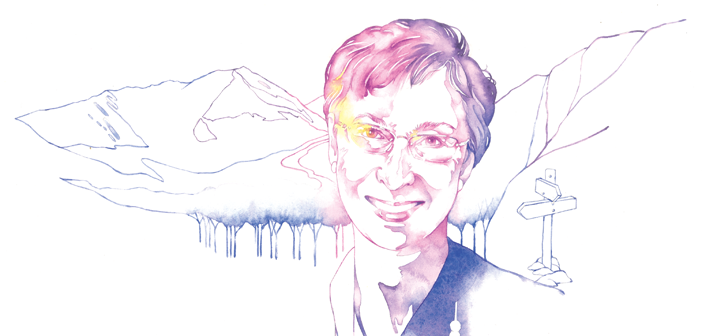The chief nursing officers of the Johns Hopkins Hospital system perform a job that demands creativity, communication, and calm under withering pressure. The system has chosen well: Karen Haller of the Johns Hopkins Hospital; Joan Vincent of Sibley Memorial; Sharon Hadsell of Howard County General; Leslie Mancuso of Jhpiego; Maria Koszalka of Bayview; Barbara Jacobs of Suburban; Cindy Driscoll of All Children’s in Florida.
In the hours away from Hopkins–their “other lives”—they follow passions as varied as photography, world travel, sailing, hiking, and horse racing, with these experiences contributing in many ways to their professional success.
Below, the CNOs of the Johns Hopkins Nursing system share what makes them tick, and how that has helped them build teams that operate like clockwork.
Illustrations by Cheryl Chalmers
[accordions ]
[accordion title=”Trail Blazer: Karen Haller, The Johns Hopkins Hospital” load=”hide”] 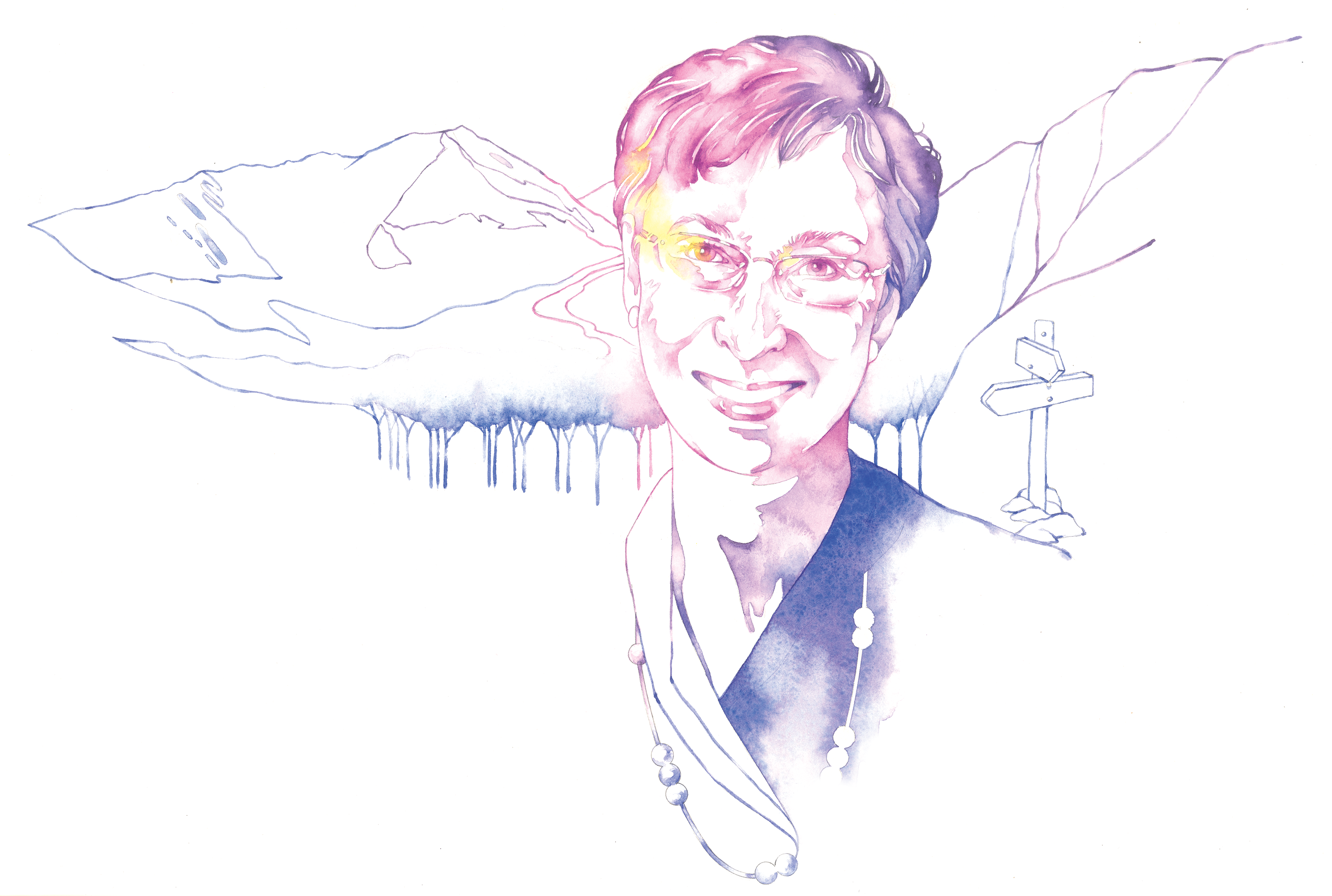
Through hiking, Karen Haller has found respite, beautiful scenery, and an unexpected lesson for other nurses
Walking down a strenuous trail from the top of Yosemite Falls on 60 boulder-covered switchbacks without railings, lifelong hiker Karen Haller, PhD, RN, came across a woman in her 20s–“vivacious and cute in her short shorts”–who had an above-the-knee amputation with a prosthetic leg. Haller watched this woman concentrate as she made her way up a switchback akin to a steep flight of stairs, slowly crossing each boulder by swinging her leg laterally over the jagged rock.
[pullquote]
“This reminded me that patients need to set goals for themselves [too], and that we need to help them achieve those goals.”
–Karen Haller, PhD, RN
[/pullquote]
In that moment, Haller, Vice President for Nursing and Patient Care Services at The Johns Hopkins Hospital, thought about the nurses, doctors, therapists, and equipment makers who may have supported this woman in achieving this unorthodox goal. “No clinician would have advised her to go on that trail,” she says. “This reminded me that patients need to set goals for themselves [too], and that we need to help them achieve those goals.” Haller said as much to Hopkins nursing graduates when she told this story during last summer’s commencement.
This wasn’t the first time hiking has complemented Haller’s career. Being in the woods outside of cell phone range allows her to take a “digital fast” from her daily life of meetings, teaching, and overseeing standard practices and clinical protocols for a nursing staff of 3,000. “Being a CNO is a 24/7 job, so I’ve never really drawn lines between work time and personal time,” she says. “Hiking controls any tendencies I might have toward being a workaholic.”
Yosemite is just one of dozens of trails that Haller has hiked since she was a girl. Then, Title IX hadn’t passed yet, so school sports for girls did not exist. Girl Scouts was the only option, and Haller was one from childhood through high school. She became inspired by her constant and demanding troop leader, who encouraged the girls to challenge themselves physically by sailing, hiking, and becoming Red Cross-certified canoeists. Haller, who says she is not a “knitting or crafts type,” was drawn to the physical challenge and spectacular scenery on the hikes.
Since then, she has gone on several hiking trips a year, from a 55-mile backpacking vacation across the Isle Royale archipelago in Lake Superior to snowshoeing in the Berkshires to short day hikes with her husband and daughter. Haller has an “enduring love affair” with national parks—some of her favorite hikes are Haleakalā Crater in Hawaii and Mount LeConte in the Smoky Mountains—because of their breathtaking vistas and long trails, often at least 10 miles.
“The beauty about hiking for me is that it takes absolutely no talent,” she says. “You can do it with your kids, you can do it with your husband, you can do it when you’re an empty nester, you can do it alone. It’s an activity that you can carry with you over your lifetime.”[/accordion]
[accordion title=”The Proper Angle: Maria Koszalka, Johns Hopkins Bayview Medical Center” load=”hide”]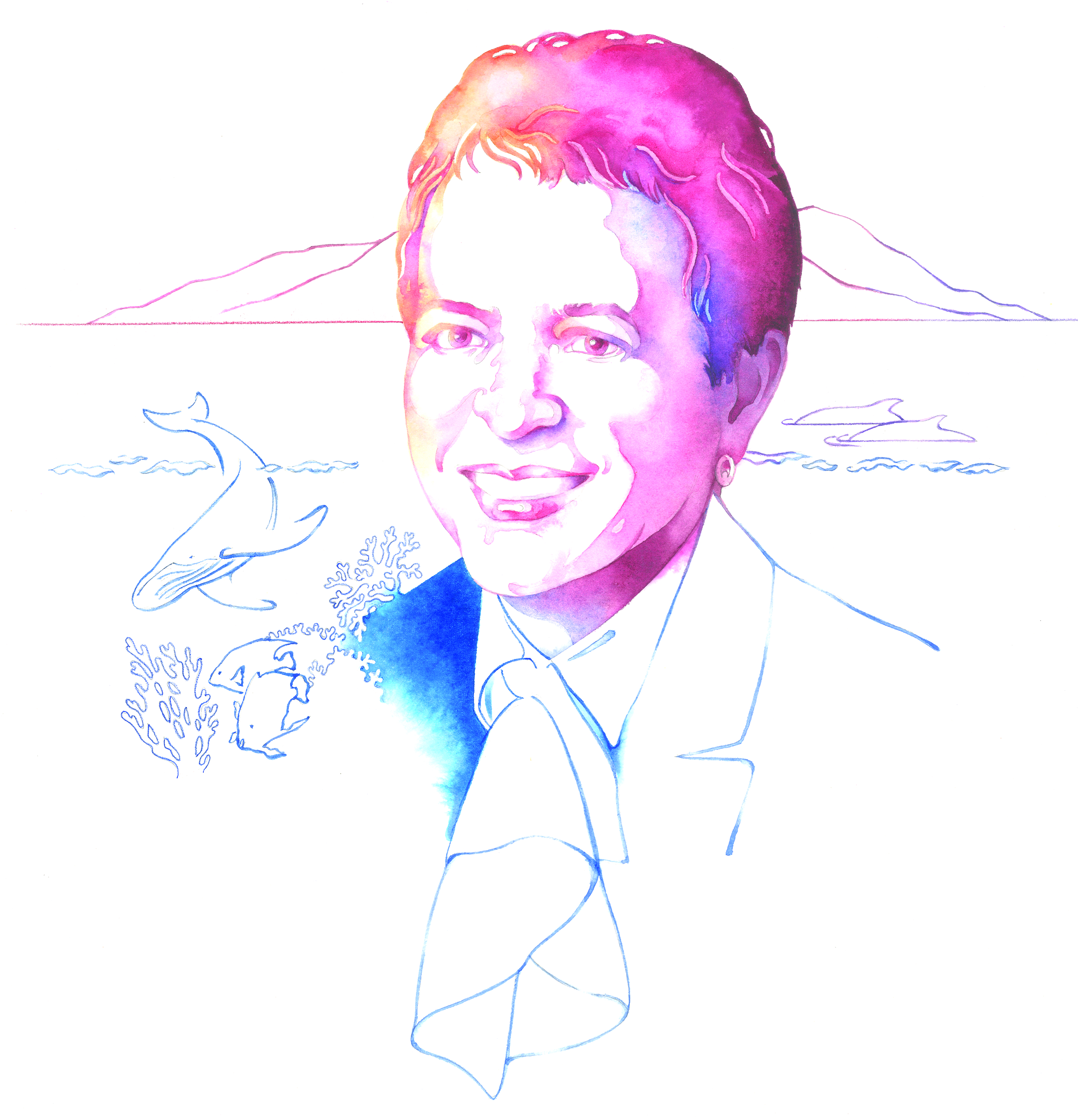
Photography has taught Maria Koszalka to embrace patience and diverse perspectives
In her office at Johns Hopkins Bayview Medical Center, Maria Koszalka, RN, Ed.D., has a photograph of a swan, “majestic and big and beautiful,” water still dripping from its feathers after it breaks the surface of Prospect Bay on Maryland’s Eastern Shore. Koszalka, Vice President of Patient Care Services, says this is her most cherished photograph, in part because it reminds her of Swan Lake, a favorite ballet. It also happens to be a photograph she took herself, one of many animals and flowers captured over the years with her D5200 Nikon digital SLR camera, among other models.
[pullquote]
Photographing animals, prone to suddenly flying off or stepping outside of a shot, has also taught Koszalka patience.
[/pullquote]
Koszalka’s father introduced her to photography. As a child, she joined him in the family’s dark room developing black and white pictures of relatives. After beginning her nursing career, she enrolled in recreational photography classes, including a memorable course aboard a whale-watching boat in Maui. From these courses, she has learned to think about different angles when framing her shots. In Maui, for example, where Koszalka travels once a year, she took a shot of a hibiscus flower with the ocean in the background, but the sky or the sand could just as easily have surrounded the flower.
“That’s what management is all about too,” says Koszalka, who has 12 direct reports and is the leader of a department with 700 nurses. “You have to listen to different perspectives to really understand an issue.”
Photographing animals, prone to suddenly flying off or stepping outside of a shot, has also taught Koszalka patience. “When you’re taking pictures of birds, and it’s not the right bird or you want to capture it in flight, you have to spend a lot of time just sitting there and waiting and taking lots of pictures,” she says. Last year, while at the beach with some friends and their dog, she took 700 photos of the poodle swimming in the water before choosing one shot and making a nice portrait as a gift.
During an impending trip to Maui, Koszalka planned to exercise patience as she hopes to capture one photograph that has eluded her: the perfect whale shot. Her annual trips to the island correspond with whale birthing season. Afterward, Koszalka takes pictures of females teaching calves to swim and jump. This time, she’d love to capture a whale herd gliding through the water, at just the right angle.[/accordion]
[accordion title=”Well Grounded: Leslie Mancuso, JHPIEGO” load=”hide”]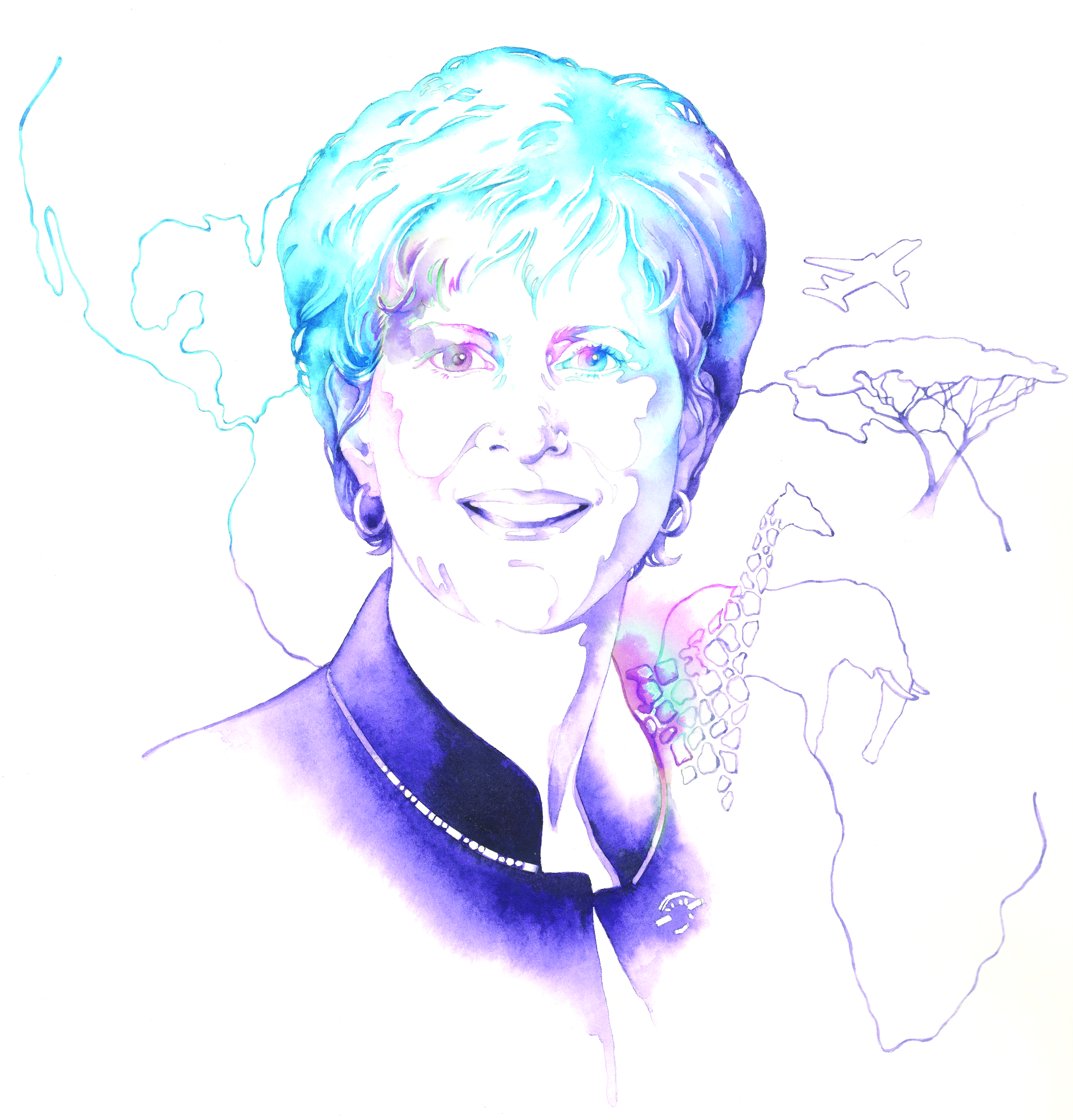
For Leslie Mancuso of Jhpiego, work and personal passion collide on her frequent travels
Leslie Mancuso, PhD, RN, was not born into a life of travel. Growing up in Connecticut, the President and CEO of Jhpiego primarily took summer trips to nearby Cape Cod. Years later, when she was on the nursing faculty at the University of Pennsylvania, Mancuso took her first international trip to Costa Rica with Project HOPE, an organization working to improve healthcare worldwide; later, she worked as a consultant in Indonesia and China, developing the skills of local nurses. “This exposure to other countries made me realize that travel is something that energizes me,” she says.
Today, Mancuso spends much of her year in the air. In 2013, she clocked in 300,000-plus airline miles while visiting 10 to 12 countries—a distinction that has landed her a New York Times profile as a “Frequent Flier”—to see Jhpiego’s maternal and child health and education programs in action. Most recently, she traveled to Burkina Faso—a poor, landlocked African country that “holds a special place in my heart,” she says—to tour a new Jhpiego program designed to reduce the high incidences of malaria among pregnant women.
[pullquote]
“Traveling has taught me that there are cultural and social practices that you have to be mindful of. It’s all about respect and understanding.”
–Leslie Mancuso, PhD, RN
[/pullquote]
On all of her trips, Mancuso also meets with Jhpiego’s partners, from U.S. Ambassadors and Ministers of Health to doctors and midwives. “I’m a nurse first and a CEO second,” she says, adding that she always makes time to meet nursing leaders. “The nurses have so little in many of our countries, whether it’s equipment or tools, but they are so innovative. I’ve learned so much from them about the strength and kindness of individuals.”
Although travel is completely tied to Mancuso’s career, it’s also a personal passion. “It’s all intertwined,” she says. “Traveling has taught me that there are cultural and social practices that you have to be mindful of. It’s all about respect and understanding.”
Mancuso even takes the less-than-thrilling aspects of travel in stride. Long plane rides offer hours of uninterrupted time when she can think strategically about Jhpiego’s future. And multiple airport checkpoints—the Democratic Republic of the Congo had 18 of them—don’t phase her. “When I meet women who live six hours away from a clinic and who need to deliver a baby, I think, ‘[These checkpoints] are nothing compared with what some mothers go through.’”
Her hectic schedule leaves Mancuso with only one weekend a month at home. Still, in addition to having dinner and seeing a movie with her husband during the first weekend in February, she also traveled, heading to Philadelphia to speak at the National Conference on Girls’ Education.
“If you were to meet me on a Saturday night, I’d be talking to you about Jhpiego,” she says. “It can sound like a one-note song, but I am passionate about meeting these people [around the world] and understanding how we can help them.”[/accordion]
[accordion title=”An Even Keel: Cindy Driscoll, All Children’s Hospital” load=”hide”]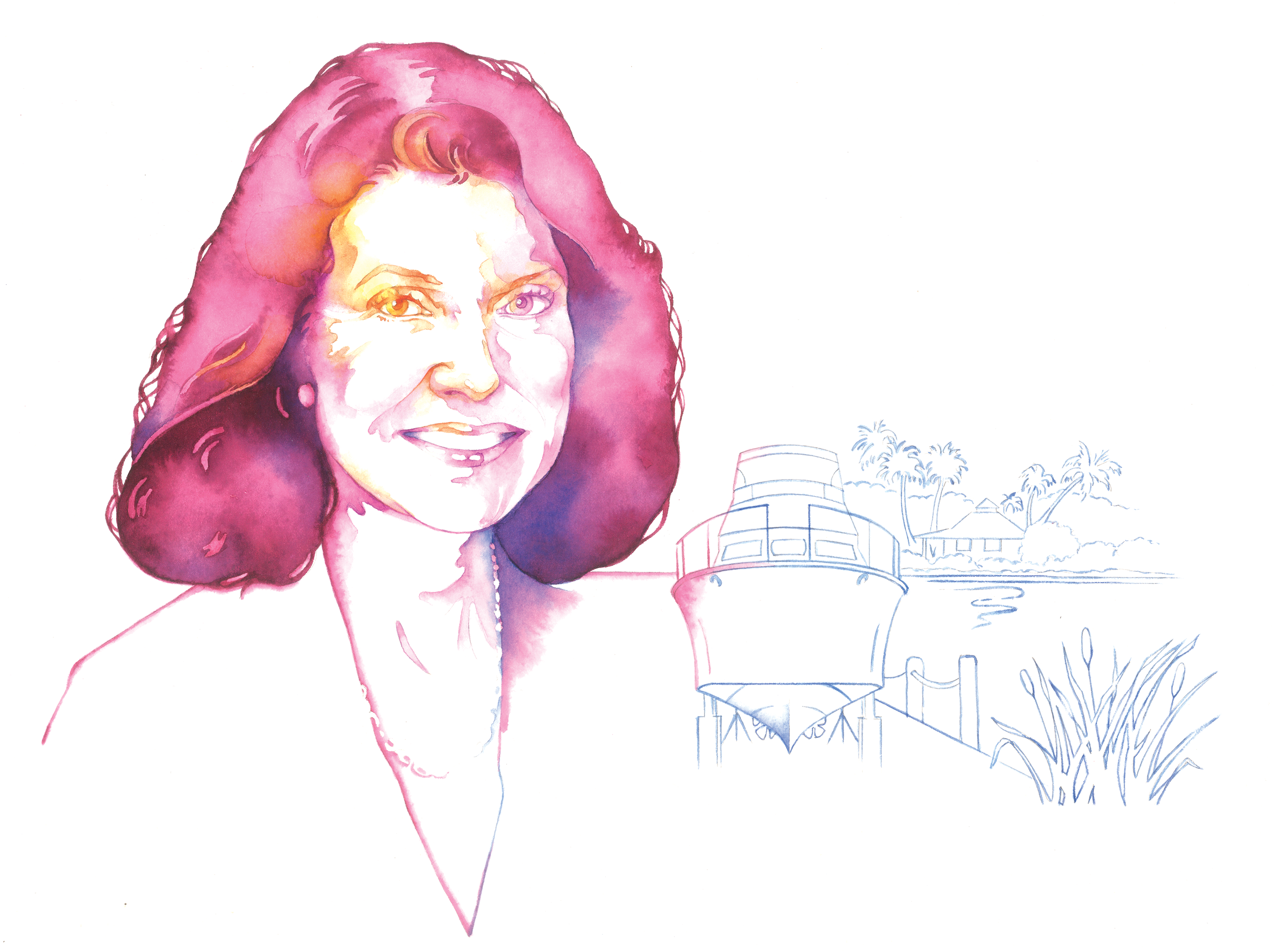
On the water or the ward, a calm demeanor helps Cindy Driscoll navigate rough spots
A decade ago, Cindy Driscoll, RN, BSN, MS, NEA-BC, and her husband came across a mission that was selling its wooden 1920s Chesapeake Bay Buyboat that it used to take supplies to those in need on Florida’s neighboring islands. Once used for fishing—there was a long well in back where fishermen could throw their catch—the yacht reminded Driscoll’s husband of the Buyboats he often saw on the Chesapeake Bay as a child. So the Driscolls bought the boat then started the long process of rehabbing it. They rebuilt the transmission, worked on the engine, and turned the fishing well into a living space with a microwave, a refrigerator, and a sink.
When the boat was ready, Driscoll, Interim Chief Nursing Officer at All Children’s Hospital, and her family often drove it to the picturesque St. Petersburg waterfront in Florida. It was here that she had her most unforgettable boating experience: She got stuck in the water. The tide was low at the time, so the Buyboat wedged into a sandbar close to the shore. After calling a coworker, who looked up the tides in the newspaper, Driscoll realized that the boat wouldn’t be moving for several hours. In that moment, she simply thought, “I guess we’re spending the night out here.”
[pullquote]
“Things can happen in a split second [on a boat],” she says. “Our steering goes out or our water hose breaks, and you have to stay calm and make decisions quickly. That’s a lot like what I do [at work].”
–Cindy Driscoll, RN, BSN, MS, NEA-BC
[/pullquote]
This ability to remain “even keel” in stressful situations serves Driscoll well both on the boat and in the hospital. “Things can happen in a split second [on a boat],” she says. “Our steering goes out or our water hose breaks, and you have to stay calm and make decisions quickly. That’s a lot like what I do [at work].”
Twenty-five years ago, for example, Driscoll had to quickly think on her feet when a fire erupted outside of the NICU in All Children’s old hospital building. Having first seen the flames from across the street, she immediately ran to the NICU and kept staff and parents calm while they evacuated the babies to an adult hospital next door.
More recently, Driscoll, the All Children’s on-call administrator at the time, learned that a baby, born at a community hospital and requiring surgery for gastroschisis, needed a bed in the NICU, which was completely full at the time. “I didn’t hesitate to take that baby,” Driscoll says. But she then had to quickly decide which baby was ready to leave the NICU to make room.
For the most part though, Driscoll feels a sense of peace on boats. Having since donated their Buyboat to the Clearwater Marine Aquarium, the Driscolls now own a 40-foot Albin Trawler that they often take on Friday night jaunts to nearby Weedon Island Preserve. There, Driscoll likes to watch the dolphins swim, eat dinner with her family, and enjoy the serenity that boating brings her.[/accordion]
[accordion title=”Full Speed Ahead: Sharon Hadsell, Howard County General Hospital” load=”hide”]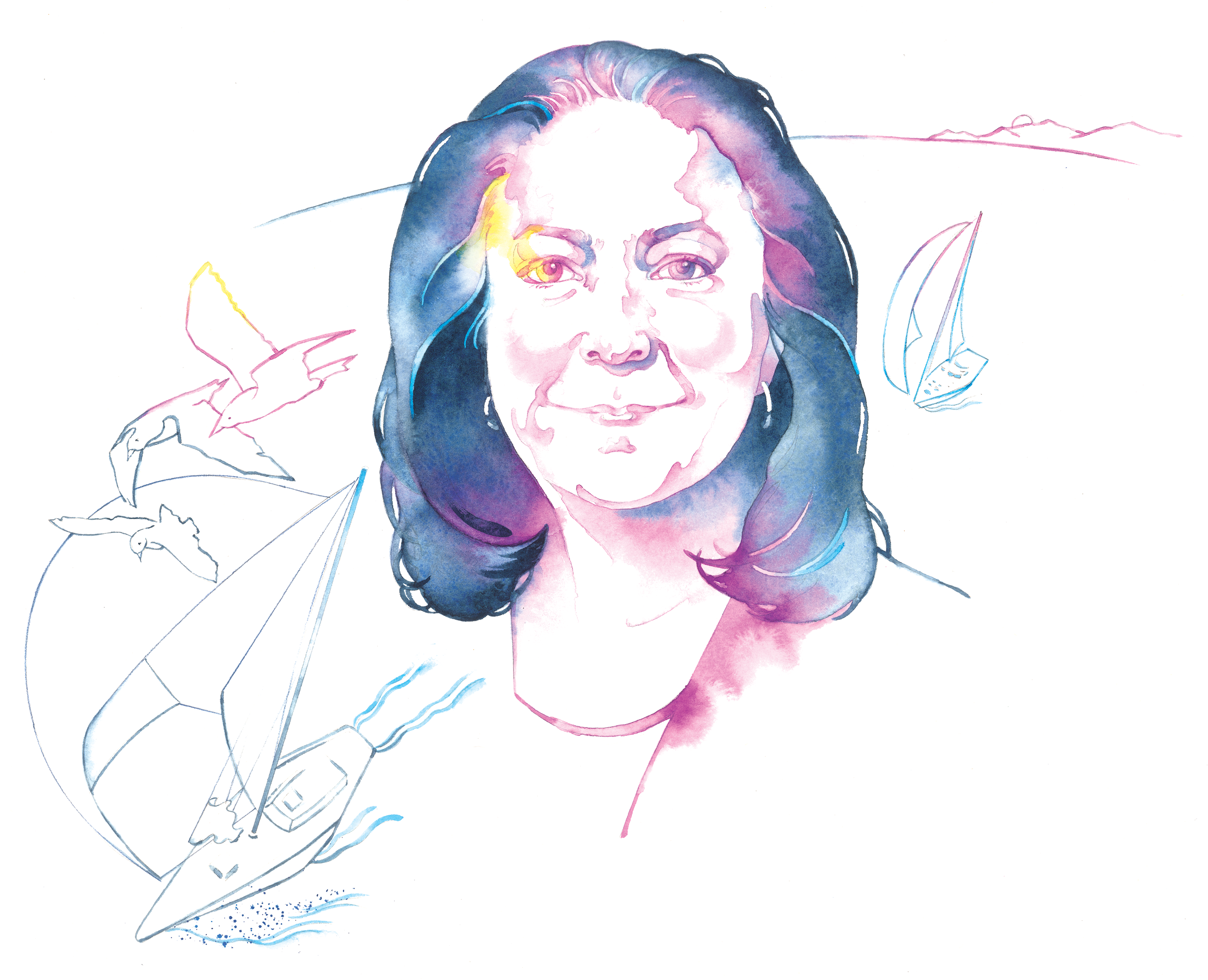
Lifelong sailor Sharon Hadsell puts varied teams on a common path
Whether setting up the U.S. Women’s Match Race Championship sailing course at St. Thomas in the U.S. Virgin Islands or managing more than 1,000 caregivers at Howard County General Hospital, Sharon Hadsell, RN, MSN, CNA-BC, often must turn groups of people with various responsibilities and backgrounds into high-functioning teams. Hadsell, a national certified race officer, has to be ready to “walk cold” into a location where the waters and equipment may be unfamiliar and quickly pull together a race committee from the assembled volunteers.
Similarly, when starting a new unit at a hospital, Hadsell, senior vice president of patient care services, works with experienced staff as well as new hires to make optimal patient care the standard from the get-go. For a new bone and joint program, “we had to pull together perioperative services, the surgery floor, physical therapists, and orthopedic surgeons—a whole group of people who hadn’t worked together before and who needed to become a team,” she says. “As a national race officer, I’ve learned how to make people feel valued and how to listen to people, and those are the [skills] I have applied in [hospital situations].”
[pullquote]
“It’s about building a team to make a race happen, and there’s a lot of satisfaction there.”
–Sharon Hadsell, RN, MSN, CNA-BC
[/pullquote]
Having sailed since she was young, Hadsell jumped at the opportunity to get involved with race management before the 1996 Olympics in Atlanta. Training was rigorous: For three years, she alternated between classroom and on-the-water training, learning to read winds, waves, and tides; how to set up and pick up marks; how to tow sailboats, handle and dock powerboats, and rescue capsized sailors. The training team also traveled to Miami and other locations to run regattas.
At the Olympics, Hadsell was the only female mark boat captain, leading a team that assisted the principal race officer in setting and monitoring the course. “I met people from all over the world, and I got to learn from some of the best race officers out there,” she says.
Her interest in race management cemented, Hadsell progressed through the hierarchy, moving from club race officer to regional race officer to national race officer. Today, she travels across the country, to Bermuda, and to St. Martin to manage races like the Star Class Western Hemisphere Championship and the Bermuda Ocean Race.
The opportunity to meet great people from around the world and to pull off a fair and competitive event keep Hadsell in racing. “[Race management] is about building a team to make a race happen, and there’s a lot of satisfaction there,” she says.[/accordion]
[accordion title=”World View: Barbara Jacobs, Suburban Hospital” load=”hide”]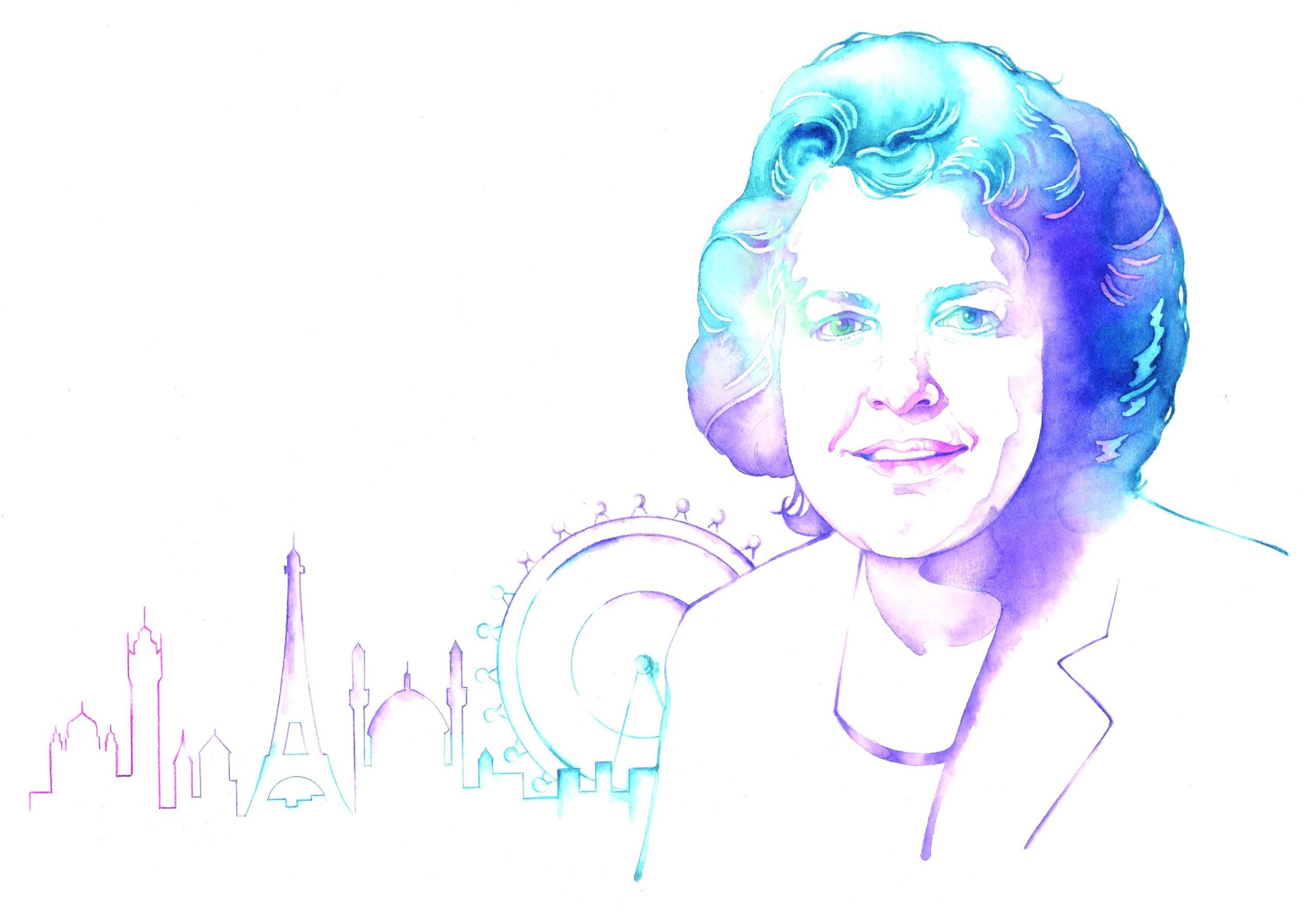
Avid traveler Barbara Jacobs finds kinship among cultures
Old alleyways wind through the Mutrah Souq, a colorful, 200-year-old market in Muscat, the capital city of Oman, a country on the southeast coast of the Arabian Peninsula. Barbara Jacobs, RN, MSN, CCRN, CENP, vividly recalls the spices and fabrics, jewelry, and pottery stacked, bundled, and displayed in inviting rows. Jacobs also remembers the warm welcome, despite the language barriers, as she and her husband traveled to small towns on paved roads, a relatively recent addition to the Omani landscape.
[pullquote]
Despite profound differences across cultures, Jacobs has seen that many commonalities exist too.
[/pullquote]
Although she is most drawn to the mingling of the old and the new on her travels, Jacobs, chief nursing officer and senior director of nursing, also finds that being immersed in unfamiliar cultures helps her bond with Suburban Hospital’s diverse patient population. “When I talk to families who are from different parts of the United States or the world, I can often say that I’ve been there, and that I was treated so nicely there,” she says. “It gives you more of an understanding [of their culture] that you wouldn’t have otherwise.”
Jacobs grew up in a family of two different American cultures. One set of relatives lived in apartments in the Bronx among restaurants, stores, and cultural activities. Other relatives in deep Appalachia lived in houses without bathrooms. Traveling to visit both groups from Chicago and Detroit, where her family lived, Jacobs thought nothing of these disparate lifestyles. “All we knew is both sides loved us and took care of us,” she says. “I think that [taught me] that there are really different cultures, and that they can all be wonderful.”
Jacobs instilled this interest in the rest of the world in her own three children during family vacations to Europe, South America, Brazil, and Argentina, and road trips across the United States. Recently, she and her husband traveled to Beijing, where her son has lived for four years. There, villagers with grass fastened on their backs shared the roadways with “millions of cars”—a mix of old and new that continues to fascinate Jacobs, who plans at least one international trip a year.
“When we just see the United States, we don’t realize how incredibly different the world is,” she says. Just as important, we don’t see the commonalities. For Jacobs, who loves finding new spots to visit, learning that people everywhere share similar human values never gets old.[/accordion]
[accordion title=”Root Cause: Joan Vincent, Sibley Memorial Hospital” load=”hide”]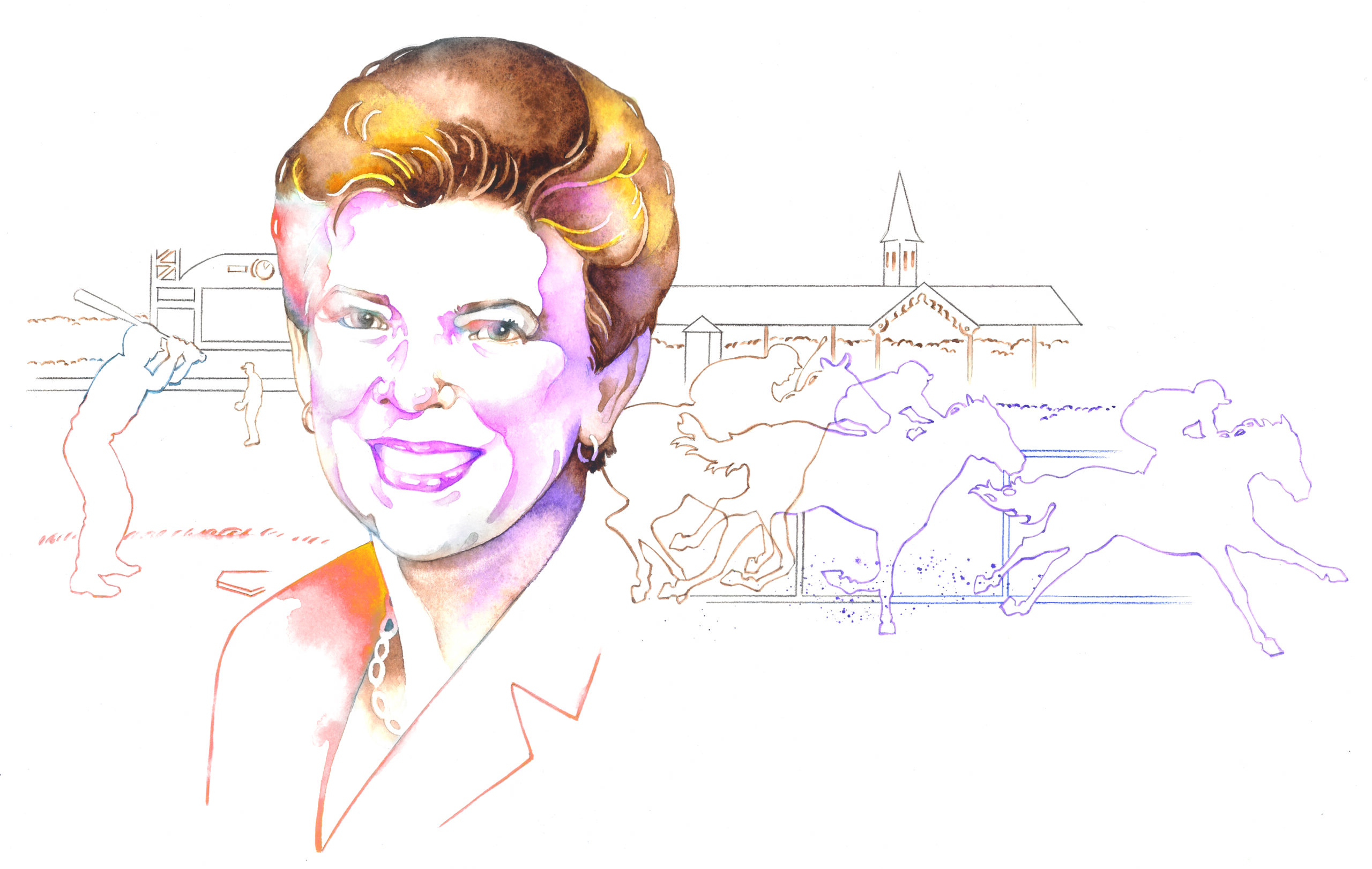
In sports and nursing, Joan Vincent has learned that effort is everything
On September 6, 1995, Joan Vincent, MSN, MS, RN, cheered from the upper level at the sold-out Oriole Park at Camden Yards, watching her idol, Cal Ripken, Jr., jog slowly around the field while a banner emblazoned with “2,131” unrolled across the adjacent warehouse. Vincent, a longtime sports fan and senior vice president for patient care services and chief nursing officer at Sibley Memorial Hospital, didn’t think she would get the chance to see Ripken’s record-breaking 2,131st consecutive game. But her husband managed to track down a gas station attendant in a small Maryland town willing to sell the tickets for around $250 each. Seeing Ripken reach his milestone now counts as her most memorable sports moment. “Cal was such a team player,” she says. “He came to work every day, and I loved that.”
[pullquote]
“You may win and you may lose, but as long as you do a really good job with the groups you are working with, that’s [what matters].”
–Joan Vincent, MSN, MS, RN
[/pullquote]
Vincent, a former cheerleader and a current fan of the Washington Nationals, Baltimore Orioles, and George Washington University women’s basketball team, has also seen plenty of games when athletes and teams play hard but finish second nonetheless. Finding a way to work around a loss is a lesson that Vincent, who oversees 800 nurses and healthcare professionals, keeps in mind as a nurse leader. “You may win and you may lose, but as long as you do a really good job with the groups you are working with, that’s [what matters],” she says.
Vincent remembers when Sibley began a campaign to improve the hospital experience for patients. After a few ideas offered mixed results, Vincent and her team kept brainstorming until they found strategies that worked, such as instituting daily “leader huddles,” a practice they learned about from Suburban Hospital. Now Sibley’s hospital leaders meet daily after rounds to talk about patient issues, and the appropriate department jumps in to fix them—a tactic to which patients have responded positively.
In addition to baseball and basketball games, Vincent and her husband also like to watch horse races, particularly the annual Pacific Classic at the Del Mar Thoroughbred Club near San Diego, CA. In 1937, Bing Crosby built this track “where the turf meets the surf,” but Vincent likes to come here to watch the “accomplished, beautiful horses” run and the jockeys maneuver the animals. “It’s a strategy, and you never know who is going to come out on top,” she says.
Baseball is the same way. “People sometimes get bored with baseball, but it’s a game where you really have to think,” Vincent adds. “Healthy competition in sports, as well as in life, demonstrates what can be accomplished when people work together.”[/accordion]
[/accordions]

